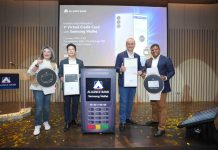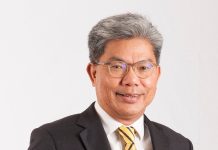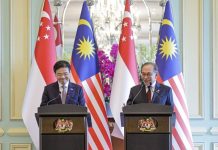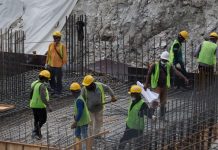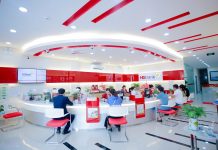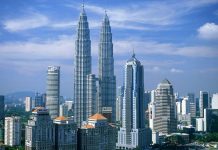Highlights:
- North Korea Commits to “complete denuclearisation”
- Singapore still part of Malaysia?
- All four Sarawak BN parties to leave coalition, form new coalition
- Tun Dr Mahahtir invites Japan to invest in Malaysia
- Proposed new car project will boost Malaysian engineering prowess
- On Robot, OptoForce Eye Southeast Asia Robotics Adoption Market, making automation within reach of SMEs
North Korea Commits to “complete denuclearisation” in joint text with US at Singapore Summit
North Korean leader Kim Jong Un has reaffirmed his “firm and unwavering commitment to complete denuclearisation of the Korean Peninsula” This was stated in a joint document signed by Mr Kim and US President Donald Trump at a historic summit in Singapore today. On the part of the US, President Trump committed to provide security guarantees to North Korea. The document however did not state what those guarantees would be. Mr Kim and President Trump met for the first time today. The historic handshake between the two world leaders took place at 9.05am at the Capella hotel in Sentosa. President Trump spoke first and said: “It’s my honour … We will have a terrific relationship I have no doubt.” Speaking in Korean, Mr Kim said that “it was not easy to get here” and “the old prejudices and practices worked as obstacles, but we have overcome them and we are here today”. The leaders then proceeded to have a one-on-one meeting with only their translators present, before stepping out after around 40 minutes to wave at the assembled media from a balcony. They were later joined by their delegations for a series of meetings. Both sides had a working lunch after their meetings.
Political boo-boo
Meanwhile, the US State Department made a political boo-boo by inferring that Singapore is still part of Malaysia. In posting the transcript of a press briefing that Secretary of State Mike Pompeo gave on Monday, the venue was described as “JW Marriott, Singapore, Malaysia” on the department’s official website. Pompeos’ briefing was a preview of what the discussions, taking place Tuesday, would entail.
All four Sarawak BN parties to leave coalition, form new coalition
All the four component parties of the Sarawak Barisan Nasional (BN) today announced their unanimous decision to leave the coalition and group themselves in a new Sarawak-based Gabungan Parti Sarawak (GPS) coalition. They four parties are Parti Pesaka Bumiputera Bersatu (PBB), Parti Rakyat Sarawak (PRS), Progressive Democratic Party (PDP) and Sarawak United People’s Party (SUPP). Sarawak BN chairman and PBB president Datuk Patinggi Abang Johari Tun Openg, in making the announcement, said the four parties would establish the Gabungan Parti Sarawak (GPS) coalition. “The decision was made after much deliberation, reflection and due consideration, taking into account the country’s current political developments post the 14th General Election. GPS will cooperate and collaborate with the Federal Government in the national interest and for the state’s rights and interests based on the Federal Constitution and the Federal of Malaysia,” he told reporters in Kuching.
Tun Dr Mahahtir invites Japan to invest in Malaysia
Prime Minister, Tun Dr Mahathir Mohamad has invited Japan to partner Malaysia in the development of Malaysia. The prime minister extended the invitation in a meeting with leaders of major Japanese economic organisations in Tokyo today. He assured them that the new Pakatan Harapan government in Malaysia would be business friendly. “We are not going to have too many bureaucratic hindrances or procedures that would deter foreign investors,” Dr Mahathir said. Dr Mahathir is currently on a three-day working visit to Japan. He also met his Japanese counterpart, Shinzo Abe. Yesterday, Dr Mahathir spoke at the 24th International Conference on the Future of Asia.
Commenting on his address at yesterday’s Nikkei Conference, Tun Dr Mahathir said that having a new national car project would help boost Malaysia’s engineering capability. The Prime Minister noted that when he first started the Proton car project back in the 1980s, Malaysia had no knowledge whatsoever about how to build cars but gradually acquired the knowledge to design, build and mass-produce cars over a period of more than two decades. Dr Mahathir said many Malaysian engineering companies had to close down because they could not supply items according to the demand of the new owners or managers of Proton. “We need to revive them because the whole idea about investing in a national car is not just about building a national car, it’s about becoming a catalyst for growing the Malaysian engineering capability.”
On Robot, OptoForce Eye Southeast Asia Robotics Adoption Market, making automation within reach of SMEs
Robotic solutions experts On Robot and OptoForce are aggressively targeting Southeast Asia, aiming to grow 250 per cent in the region this year. Demand will come from the electronics, automotive and CNC machining industries. This follows the appointment of Niels Ole Sinkbæk Sørensen as Area Sales Manager, Asia Pacific, who oversees business expansion in the region for both companies, based in Kuala Lumpur. From 2010 to 2015 robot numbers rose 70 per cent to 887,400 units. By 2025, it is estimated that 700,000 cobots will be installed globally. Mr. Sørensen is recruiting and training a local team of technical, sales and marketing talents. Over 15 technology distributors and system integrators in Southeast Asia, who are well versed with local markets, are being trained on product knowledge and applications. Industrial robot uptake is accelerating in Asia. Commenting on the promise of Southeast Asia, Mr. Sørensen said, “We see increasing robotic solution adoption in Southeast Asia with Singapore, Thailand and Malaysia leading the region in industrial robot density. This makes the region an important market with huge potential.” “Advances in robotics and automation technology such as collaborative robots (cobots) will change the face of work in Southeast Asia. The technology is transforming industries, increasing productivity and output quality while improving workers’ wellbeing by reducing the burden of repetitive and strenuous tasks. Employees are now able to program and operate robots easily with minimal training and technical skills,” said Niels. “Robotic technology is helping businesses automate their processes easily, operate more sustainably and provide safer working conditions. Our technology allows robots to be programmed to perform complex, intricate tasks and work safely alongside people. Subsequently, workers can focus on tasks that require ingenuity and dexterity, while robots manage repetitive and strenuous tasks. “We invest significantly in R&D and have developed technologies that are affordable for SMEs and foster easy automation adoption. Our tools are safe and easily deployed. They can be programmed by workers without any prior knowledge in robotics, making automation well within reach for SMEs in the region,” added Niels.
















